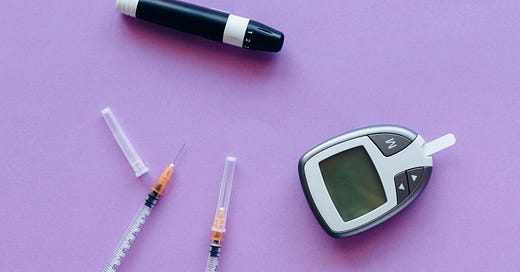My name is Aminah Louise, and I am a Cleveland, Ohio-based belly dancer. I’ve been dancing since 2011 and performing publicly since 2013. However, in the winter of 2015, my life took a dramatic turn. In the weeks leading up to that moment, I experienced persistent hunger and thirst, frequent bathroom trips, and relentless fatigue. At the time, I was dealing with significant stress, which led me to attribute these symptoms to a potential nervous breakdown. I even discussed with my mother the possibility of checking myself into the hospital if things didn’t improve.
Then, one Tuesday morning, I called my workplace to explain I would be late due to exhaustion. During that conversation, I shared my physical symptoms with my mother, who also has Type 1 Diabetes. Sensing something was amiss, she tested my blood sugar using her meter. The reading was in the 300s—a stark warning sign for someone without diabetes. We rushed to the Emergency Room, where, hours later, my mother’s worst fear was confirmed: I had been diagnosed with Type 1 Diabetes.
What Is Diabetes?
Diabetes Mellitus is a condition characterized by the failure of the beta cells in the pancreas to produce insulin, the hormone responsible for regulating blood sugar levels. There are two primary types: Type 1 and Type 2. In Type 1 Diabetes, the pancreas produces no insulin at all, necessitating the use of synthetic insulin to manage blood sugar. This type is more difficult to control and is relatively rare, with no known cure. Conversely, Type 2 Diabetes arises when the beta cells do not respond properly to insulin, a phenomenon known as insulin resistance. While Type 2 is more common and manageable through medications, lifestyle adjustments, and dietary changes, it also currently lacks a cure.
It’s essential to address a common myth about diabetes: I did not develop this condition due to my diet or sugar consumption. My diabetes was triggered by ongoing stress—an unfortunate response my body had after months of pressure. My diabetes was triggered by ongoing stress—an unfortunate response my body had after months of pressure. I had a relatively healthy diet before my diagnosis, and I know others who have led healthy lifestyles yet were diagnosed with Type 1 Diabetes due to various factors, including genetics or unexpected health events. Diabetes is influenced by a mix of lifestyle, trauma, and genetics; food and weight play a minimal role in its onset.
It’s also important to recognize that various factors affect blood sugar levels. From diet to sleep quality, stress, and even minor illnesses like the common cold, many elements come into play. Other medications, such as birth control, can also impact blood sugar.
The Challenges of Being a Dancer with Type 1 Diabetes...and Some Tips
Living with a chronic illness like diabetes presents unique challenges, especially as a dancer. I’m not here to name names or shame anyone, particularly given the limited information available about Type 1 Diabetes. There was an incident at one performance when my dance company was informed that we could not store our belongings behind our table because the downstairs dressing room was unavailable. I requested to keep my glucose meter and insulin in my director's bag, explaining the necessity of having them on hand. Initially, she declined, but after I emphasized the risk of Diabetic Ketoacidosis (DKA), she relented—only to forget my supplies in her car, forcing me to drive two hours at 2 a.m. to retrieve them.
There have been moments when I considered backing out of a performance due to dangerously high or low blood sugar levels. Even during practice, challenges arise. Type 1 Diabetes can be unpredictable. For instance, if I’m rehearsing in a hot, muggy environment, my blood sugar may drop unexpectedly. I often find myself sidelined, needing to eat or drink something to stabilize my levels, only to feel fatigued afterward. Conversely, an adrenaline rush from performing can cause my blood sugar to rise, leading to further complications.
In light of these experiences, here are a few tips for those directing, teaching, or working with diabetic dancers:
Understand the Need for Flexibility: We may have to withdraw from a performance if our blood sugar is not cooperating. We strive to prepare thoroughly, but sometimes circumstances are beyond our control. Please be understanding in these moments.
Be Open to Costume Adjustments: For dancers using insulin pumps or glucose meters, modifications may be necessary. It’s essential to accommodate these medical devices during performances.
Acknowledge Individual Differences: Every diabetic is unique. What works for one person may not work for another. For instance, I find it more effective to take my long-acting insulin at night, while someone else might prefer to split their doses. Some dancers may need snacks during rehearsals, while others may not. Recognizing these differences is crucial for fostering a supportive environment onstage.
I titled this article "Dancing with Diabetes" because living with this condition is, quite literally, a dance. Sometimes I lead, and other times, diabetes takes the lead. It’s an ongoing series of trials and adjustments. By sharing my experiences and these tips, I hope to encourage more diabetic dancers to come forward, sharing their stories and strategies, thus fostering a deeper understanding within the dance community.
About the Author:
Aminah Louise has been gracing the stages of the Midwest since 2013. Known for her fierce talent and unapologetic attitude, she has created a style called 'ExperiMental Bellydance'. She is also a proud teacher at Cleveland Eclectic Dance.





